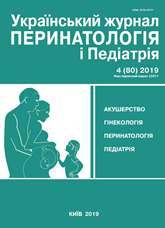Vitamins and microelements as specific regulators of physiological and metabolic processes in the body of children and adolescents
DOI:
https://doi.org/10.15574/PP.2019.80.75Keywords:
vitamins, microelements, physiological and metabolic processes, childrenAbstract
The review shows that vitamins are not a source of energy or plastic material, but they play an important role in specific regulators of physiological and metabolic processes that underlie the implementation of most vital functions of the body, balanced work of all its organs and systems. On the other hand, it is emphasized that micro- and macroelements are essential substances and include a several compounds involved in the construction of organs, tissues, cells and their components, the maintenance of ionic balance in cells, the regulation of the activity of many enzymes. The main causes of vitamin deficiency in childhood and the age requirement of vitamins and trace elements in different periods of childhood and adolescence are highlighted. The importance of the issue of the need for additional complementation of children with complexes of vitamins and trace elements and the need for an individual approach to solve the problem in each case is emphasized, as lately the diet of children and teenagers in Ukraine has become increasingly a feature of the Western diet, given the depletion of soils and, consequently, the reduction of vitamins and trace elements in the growing fruits. Particularly vulnerable categories are children of the first years of life, because during this period are the processes of maturation of organs and tissues of the body, as well as teenagers, most of which have distorted eating behavior and eating disorders. The groups of children for whom supplementation is mandatory are listed: with anorexia, poor appetite and those who practice dieting; with chronic diseases (cystic fibrosis, inflammatory bowel disease, liver, etc.); families with disadvantaged socio_economic background, orphans / abandoned children; those who are in diet programs to reduce weight; those who do not consume milk and dairy products; children with developmental delays.No conflict of interest were declared by the author.
References
Beketova NA, Spiricheva TV, Pereverzeva OG i dr. (2009). Izuchenie obespechennosti vodo- i zhirorastvorimyimi vitaminami vzroslogo trudosposobnogo naseleniya v zavisimosti ot vozrasta i pola. Voprosyi pitaniya. 6: 53-59.
Borovik TE, Ladodo KS (red.). (2015). Klinicheskaya dietologiya detskogo vozrasta. Rukovodstvo dlya vrachey. Moskva.
Emelyanova TP (sost.). (2001). Vitaminyi i mineralnyie veschestva. Polnyiy spravochnik dlya vrachey. Moskva: ID «Ves».
Markdante KDzh, Klihman RM. (2019). Osnovy pediatrii za Nelsonom (Per. 8-ho anhl. vyd.T. 1). Kyiv.
Martinchik AN, Maev IV, Yanushkevich OO. (2005). Obschaya nutritsiologiya. Moskva: MEDpress-inform.
Mindel E (sost.). (1997). Spravochnik po vitaminam i mineralnyim veschestvam (per. s angl.). Moskva: Meditsina i pitanie.
Ministerstvo okhorony zdorov'ia Ukrainy (2017). Pro zatverdzhennia norm fiziolohichnykh potreb naselennia Ukrainy v osnovnykh kharchovykh rechovynakh i enerhii. Nakaz No. 1073 vid 03.09.2017. https://zakon.rada.gov.ua/laws/show/z1206-17/page.
Pitanie materi i rebenka (2008). Noveyshaya entsiklopediya meditsinskihznaniy. Moskva: Eksmo.
Rebrov VG, Gromova OA. (2003). Vitaminyi i mikroelementyi. Moskva.
Samur PK, Kinh K. (2012). Kharchuvannia u pediatrii (4-te vyd.). Lviv: Medytsyna svitu.
Skalnyiy AV. (2010). Mikroelementyi: bodrost, zdorove, dolgoletie. Moskva: Eksmo.
Tutelyan VA, Kon IYa (Red.). (2013). Detskoe pitanie. Rukovodstvo dlya vrachey. 3-eizd. Moskva.
Kharchenko NV, Anokhina HA (Red.). (2012). Diietolohiia. Kyiv.
Shabrov AV, Dadali VA, Makarov VA. (2003). Biohimicheskie svoystva mikronutrientov pischi. Moskva: Eksmo.
Shtabskyi BM, Fedorenko VI; Tsypriian VI (Red.). (2007). Hihiiena kharchuvannia z osnovamy nutrytsiolohii. Pidruchnyk (u 2 kn.). Kyiv: Medytsyna.
Kliegman RM, Stanton BF, St Geme JW et al. (2016). Nelson Textbook of Pediatrics (20 ed). Elsevier: Philadelphia.
Krebs NF, Hambidge KM, Duggan C et al. (2008). Trace elements. Nutrition in Pediatrics: Basic Science and Clinical Applications (4thed). BC Decker: Hamilton, Ontario.
Kumar J, Munter P, Kaskel F et al. (2009). Prevalence and association of vitamin D deficiency in US children: NHANES 2001-2004. Pediatrics. 124(3): e362-e370. https://doi.org/10.1542/peds.2009-0051; PMid:19661054 PMCid:PMC3749840
Spirichev VB. (2013) To the substantiation of the joint use of vitamin D and the rest of the 12 vitamins necessary to the creation and realization of the vital functions of its hormone-active form (the vitamin D + 12 vitamins approach). J Nutr Ther. 2 (1): 1-7. https://doi.org/10.6000/1929-5634.2013.02.01.1
Wagner CL, Greer FR. (2008). Prevention of rickets and vitamin D deficiency in infants, children and adolescents. Pediatrics: 122. https://doi.org/10.1542/peds.2008-1862; PMid:18977996
Downloads
Issue
Section
License
The policy of the Journal “Ukrainian Journal of Perinatology and Pediatrics” is compatible with the vast majority of funders' of open access and self-archiving policies. The journal provides immediate open access route being convinced that everyone – not only scientists - can benefit from research results, and publishes articles exclusively under open access distribution, with a Creative Commons Attribution-Noncommercial 4.0 international license(СС BY-NC).
Authors transfer the copyright to the Journal “MODERN PEDIATRICS. UKRAINE” when the manuscript is accepted for publication. Authors declare that this manuscript has not been published nor is under simultaneous consideration for publication elsewhere. After publication, the articles become freely available on-line to the public.
Readers have the right to use, distribute, and reproduce articles in any medium, provided the articles and the journal are properly cited.
The use of published materials for commercial purposes is strongly prohibited.

